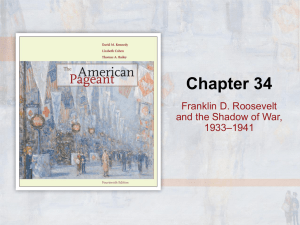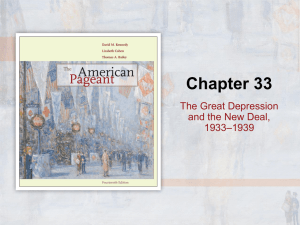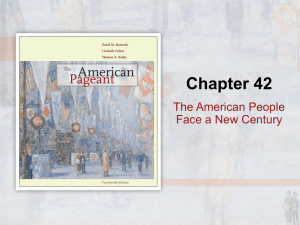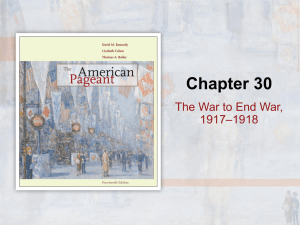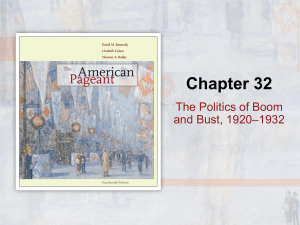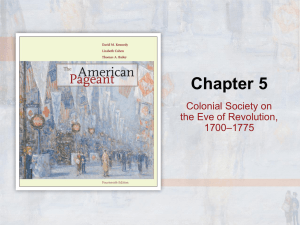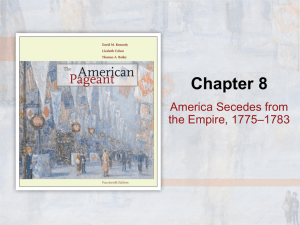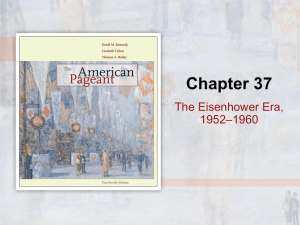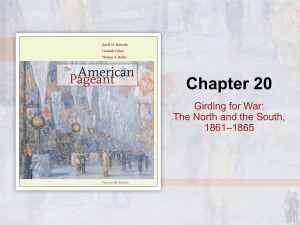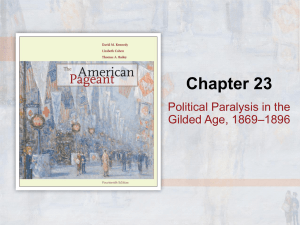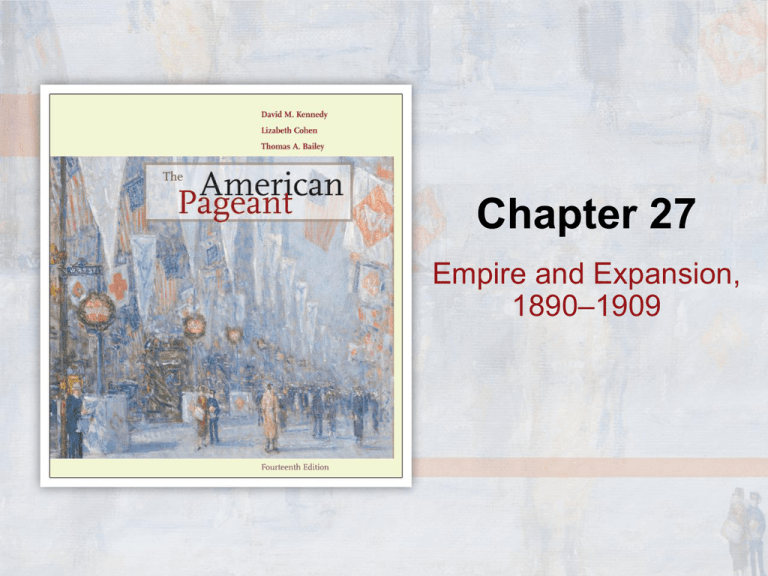
Chapter 27
Empire and Expansion,
1890–1909
Question
All of the following were true of the Big Sister Policy
EXCEPT
a) Secretary of State James G. Blaine attempted to rally Latin
American nations behind American leadership and open their
markets to U.S. traders.
b) the policy bore fruit in 1889, when Blaine presided over the
First International conference of American States.
c) it was a less violent fore-runner of Theodore Roosevelt’s “Big
Stick” diplomacy, which focused on removing Queen
Liliuokalani from the Hawaiian throne.
d) it was the modest beginnings of an increasingly important
series of inter-American assemblages.
Copyright © Cengage Learning. All rights reserved.
27 | 2
Answer
All of the following were true of the Big Sister Policy
EXCEPT
a) Secretary of State James G. Blaine attempted to rally Latin
American nations behind American leadership and open their
markets to U.S. traders.
b) the policy bore fruit in 1889, when Blaine presided over the
First International conference of American States.
c) it was a less violent fore-runner of Theodore Roosevelt’s “Big
Stick” diplomacy, which focused on removing Queen
Liliuokalani from the Hawaiian throne. (correct)
d) it was the modest beginnings of an increasingly important
series of inter-American assemblages.
Hint: See pages 670–671.
Copyright © Cengage Learning. All rights reserved.
27 | 3
Question
All of the following were true of the Great Rapprochement
EXCEPT
a) it came in the wake of the Venezuela crisis of 1895.
b) the chastened British, their eyes fully opened to the European
peril, were now determined to cultivate Yankee friendship.
c) the British inaugurated an era of “twisting the lion’s tail,” which
replaced a century or so of America’s “patting the eagle’s
head.”
d) the new Anglo-American cordiality became a cornerstone of
both nations’ foreign policies as the twentieth century opened.
Copyright © Cengage Learning. All rights reserved.
27 | 4
Answer
All of the following were true of the Great Rapprochement
EXCEPT
a) it came in the wake of the Venezuela crisis of 1895.
b) the chastened British, their eyes fully opened to the European
peril, were now determined to cultivate Yankee friendship.
c) the British inaugurated an era of “twisting the lion’s tail,” which
replaced a century or so of America’s “patting the eagle’s
head.” (correct)
d) the new Anglo-American cordiality became a cornerstone of
both nations’ foreign policies as the twentieth century opened.
Hint: See pages 671–672.
Copyright © Cengage Learning. All rights reserved.
27 | 5
Question
Insurrectos were
a) Venezuelans, arming against possible British
incursion in 1895.
b) Cubans, rising against their Spanish
oppressors in 1895.
c) Puerto Ricans, fighting for autonomy from
Spain in 1898.
d) Filipinos, preparing for battle against U.S.
invaders in 1898.
Copyright © Cengage Learning. All rights reserved.
27 | 6
Answer
Insurrectos were
a) Venezuelans, arming against possible British
incursion in 1895.
b) Cubans, rising against their Spanish
oppressors in 1895. (correct)
c) Puerto Ricans, fighting for autonomy from
Spain in 1898.
d) Filipinos, preparing for battle against U.S.
invaders in 1898.
Hint: See page 673.
Copyright © Cengage Learning. All rights reserved.
27 | 7
Question
All of the following were true of the Roosevelt Corollary to
the Monroe Doctrine EXCEPT
a) it was a brazen policy of “preventive intervention.”
b) in the event of future financial malfeasance by Latin American
nations, the U.S. would intervene, take over the customshouses, pay off the debts, and keep troublesome Europeans on
the far side of the Atlantic.
c) it meant that no outsiders could push around the Latin nations,
even Uncle Sam, Policeman of the Caribbean.
d) this new brandishing of the big stick in the Caribbean became
effective in 1905, when the U.S. took over the management of
tariff collections in the Dominican Republic.
Copyright © Cengage Learning. All rights reserved.
27 | 8
Answer
All of the following were true of the Roosevelt Corollary to
the Monroe Doctrine EXCEPT
a) it was a brazen policy of “preventive intervention.”
b) in the event of future financial malfeasance by Latin American
nations, the U.S. would intervene, take over the customshouses, pay off the debts, and keep troublesome Europeans on
the far side of the Atlantic.
c) it meant that no outsiders could push around the Latin nations,
even Uncle Sam, Policeman of the Caribbean. (correct)
d) this new brandishing of the big stick in the Caribbean became
effective in 1905, when the U.S. took over the management of
tariff collections in the Dominican Republic.
Hint: See page 693.
Copyright © Cengage Learning. All rights reserved.
27 | 9
Question
The Teller Amendment applied to
a) the Federal Reserve system.
b) interstate commerce in banking.
c) the Spanish-American War appropriations
bill.
d) the Cuban constitution.
Copyright © Cengage Learning. All rights reserved.
27 | 10
Answer
The Teller Amendment applied to
a) the Federal Reserve system.
b) interstate commerce in banking.
c) the Spanish-American War appropriations
bill. (correct)
d) the Cuban constitution.
Hint: See pages 675–676.
Copyright © Cengage Learning. All rights reserved.
27 | 11
Question
All of the following were true of the Anti-Imperialist
League EXCEPT it
a) was a diverse group formed in order to protest
American colonial oversight in the Philippines.
b) included university presidents, industrialists,
clergymen, and labor leaders.
c) was Strongest in the Northeast, and was the largest
lobbying organization on a U.S. foreign-policy issue
until the end of the nineteenth century.
d) gained in strength after hostilities broke out between
Filipino nationalists and American forces.
Copyright © Cengage Learning. All rights reserved.
27 | 12
Answer
All of the following were true of the Anti-Imperialist
League EXCEPT it
a) was a diverse group formed in order to protest
American colonial oversight in the Philippines.
b) included university presidents, industrialists,
clergymen, and labor leaders.
c) was Strongest in the Northeast, and was the largest
lobbying organization on a U.S. foreign-policy issue
until the end of the nineteenth century.
d) gained in strength after hostilities broke out between
Filipino nationalists and American forces. (correct)
Hint: See page 682.
Copyright © Cengage Learning. All rights reserved.
27 | 13
Question
The Insular Cases addressed all of the following
questions EXCEPT
a) did the Constitution follow the flag?
b) did American laws, including tariff laws and the Bill of
Rights, apply with full force to the newly acquired
possessions?
c) are we Puerto Rican petitioners citizens or are we
subjects?
d) are U.S. military personnel “insulated” from war
crime prosecution?
Copyright © Cengage Learning. All rights reserved.
27 | 14
Answer
The Insular Cases addressed all of the following
questions EXCEPT
a) did the Constitution follow the flag?
b) did American laws, including tariff laws and the Bill of
Rights, apply with full force to the newly acquired
possessions?
c) are we Puerto Rican petitioners citizens or are we
subjects?
d) are U.S. military personnel “insulated” from war
crime prosecution? (correct)
Hint: See page 683.
Copyright © Cengage Learning. All rights reserved.
27 | 15
Question
The Platt Amendment applied to
a) the Federal Reserve system.
b) interstate commerce in banking.
c) the Spanish-American War appropriations
bill.
d) the Cuban constitution.
Copyright © Cengage Learning. All rights reserved.
27 | 16
Answer
The Platt Amendment applied to
a) the Federal Reserve system.
b) interstate commerce in banking.
c) the Spanish-American War appropriations
bill.
d) the Cuban constitution. (correct)
Hint: See page 683.
Copyright © Cengage Learning. All rights reserved.
27 | 17
Question
The Open Door Note was issued by
a) James G. Blaine.
b) John Paunceforth Hay.
c) Elihu Root.
d) Theodore Roosevelt.
Copyright © Cengage Learning. All rights reserved.
27 | 18
Answer
The Open Door Note was issued by
a) James G. Blaine.
b) John Paunceforth Hay. (correct)
c) Elihu Root.
d) Theodore Roosevelt.
Hint: See page 688.
Copyright © Cengage Learning. All rights reserved.
27 | 19
Question
All of the following were true of the Hay-Pauncefote Treaty
EXCEPT it
a) was signed between the United States and Great Britain, giving
Americans a free hand a free hand to build a canal in Central
America.
b) urged the great powers to respect Chinese rights and free and
open competition within their spheres of influence.
c) nullified the Clayton–Bulwer Treaty of 1850, which prohibited
the British or the United States from acquiring territory in
Central America.
d) conceded the right to fortify a Canal as well.
Copyright © Cengage Learning. All rights reserved.
27 | 20
Answer
All of the following were true of the Hay-Pauncefote Treaty
EXCEPT it
a) was signed between the United States and Great Britain, giving
Americans a free hand a free hand to build a canal in Central
America.
b) urged the great powers to respect Chinese rights and free and
open competition within their spheres of influence. (correct)
c) nullified the Clayton–Bulwer Treaty of 1850, which prohibited
the British or the United States from acquiring territory in
Central America.
d) conceded the right to fortify a Canal as well.
Hint: See pages 690–691.
Copyright © Cengage Learning. All rights reserved.
27 | 21

